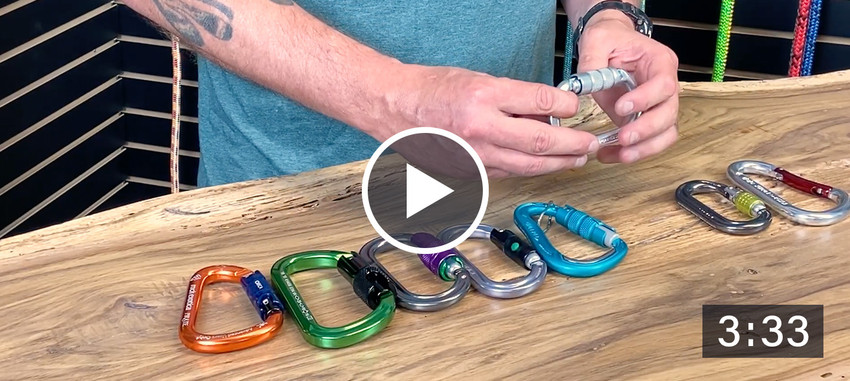Carabiner Gates
Video Sep 18th 2020There’s a wide variety of carabiners, so which do you need? We’re covering them all and going over different locking mechanisms and rotations.
Video Transcript
Brandon:
I’m Brandon with Sherrilltree, and today we’re going to discuss the different types of carabiner gates used in arborist climbing systems. There’s a wide selection available, and understanding how they work is essential for choosing the right one for the job.
Non-Locking Carabiners
Here we have a standard non-locking carabiner with a simple paddle gate. This type is common across many industries. The gate opens and closes automatically, but there’s no locking mechanism, so nothing prevents it from opening under force. Because of that, non-locking carabiners should not be used for life support.
Screw Gate Carabiners
Next is a DMM Screw Gate. With this style, the gate can remain unlocked if the screw sleeve isn’t tightened down. But once you thread the sleeve closed, it secures the gate. Screw gates are reliable for certain uses, but they require manual action and constant attention to ensure they stay locked.
Twist-Lock Carabiners
Moving one step further, we have a twist-lock carabiner. This gate requires two actions: rotate the sleeve and then open the gate. When released, it automatically closes and locks. Twist-locks are safer than screw gates but are still not the highest standard for life support.
Triple-Action, Double Auto-Locking Carabiners
For life support in arborist work, you must use a triple-action, double auto-locking carabiner. These require three distinct actions—such as lifting, twisting, and opening the gate—before it can be opened. Once released, the gate automatically closes and locks. This ensures maximum safety when climbing.
Ball-Lock Carabiners
Petzl’s Ball-Lock design is a well-known style that falls under the triple-action, double auto-locking category. It features a green button: push, twist, then open. Once released, the gate resets and locks automatically.
Quad-Lock Carabiners
DMM’s Quad-Lock takes things a step further. To open, you twist the sleeve, push it up, rotate in the opposite direction, and then open the gate. It’s more secure than a standard triple-action carabiner, offering additional peace of mind for climbers concerned about accidental opening.
ANSI 3600-lb Gate Rated Carabiners
Many modern carabiners now feature ANSI-rated 3,600 lb gates. This means the gate itself can withstand 3,600 pounds of force. Combined with a triple-action, double auto-locking mechanism, these carabiners provide both strength and safety for arborist rigging and climbing.
Rock Exotica ORCA-Lock
The Rock Exotica ORCA-Lock is a unique design. ORCA stands for Open Regular, Close Automatically. It allows the climber to preset the gate in an open position for quick clipping. Once fully opened and released, it functions like a normal auto-locking gate.
However, it’s important to note: because the ORCA can be left partially open, it is not recommended for life support. It’s best used in situations where fast clipping is beneficial, but not where the climber’s life depends on it.
Key Takeaway
There are many gate styles across arborist carabiners, but for life support applications you should always use a triple-action, double auto-locking carabiner rated at 5,000 lbs or more. These provide the security, strength, and reliability required for professional tree climbing.

